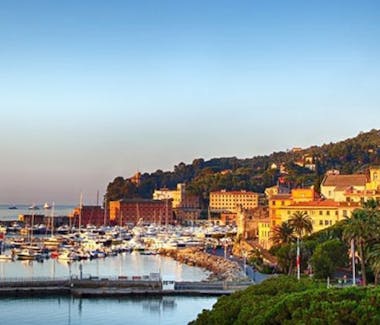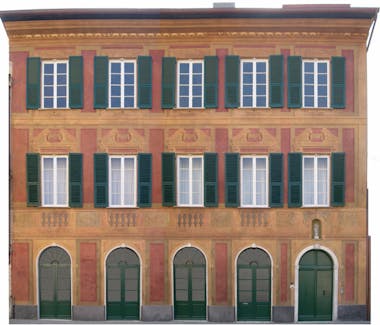Attraktionen
Basilica di S. Stefano, Piazza Marconi Guglielmo, Lavagna, Metropolitan City of Genoa, Italy
Basilica di Santo Stefano
The collegiate basilica of Santo Stefano is a Catholic place of worship in the municipality of Lavagna, in Piazza Guglielmo Marconi, in the metropolitan city of Genoa. The church is the seat of the homonymous parish of the vicariate of Chiavari-Lavagna of the diocese of Chiavari.
Parco regionale di Portofino, Portofino, Metropolitan City of Genoa, Italy
Parco naturale regionale di Portofino
The regional nature park of Portofino is a protected natural area located in the Riviera di Levante, about thirty kilometres east of Genoa, in the geographical area of the eastern Paradise Gulf and western Tigullio. It consists mainly of the municipalities of Camogli, Portofino and Santa Margherita Ligure, the latter being the seat of the park and the Portofino marine protected natural area. The park was established by law 1251 of 20 June 1935.

Oasi Naturale del Golfo di Tigullio
Oasi naturale del Golfo di Tigullio
Tigullio is a territorial area that is part of the metropolitan city of Genoa, in Liguria. The territory - inserted between the district of Golfo Paradiso and Val Bisagno to the west, Val Trebbia and Val d'Aveto to the north, Val di Vara and the district Baie del Levante to the east - mainly includes the coastal municipalities of Portofino, Santa Margherita Ligure, Rapallo, Zoagli, Chiavari, Lavagna and Sestri Levante. The main centres by population are Rapallo (29,796 inhabitants) and Chiavari (27,494 inhabitants). The total coastal population is about 100,000 inhabitants, to which can be added a further 30/35,000 inhabitants of the adjacent areas linked to the Tigullio, specifically Val Fontanabuona, Val Graveglia, Val Sturla, Val d'Aveto and Val Petronio. Historically important geographical area during the dominion of the Republic of Genoa, with the subdivision of the territory into podesterie and two capitaneati (Rapallo and Chiavari), and "headquarters" of one of the most important families of the Genoese nobility, the Fieschi di Lavagna, even in Napoleonic times the Tigullio knew important phases with the promotion of Chiavari as the capital of the Department of the Apennines and later, with the Kingdom of Sardinia, capital of the province of the same name between 1817 and 1859. Today the Tigullio area is a destination for holiday tourism, which is the main economic activity of the territory.

Via Edoardo Riboli, 14, Lavagna, Italy
Casa Carbone - Bene FAI
Inhabited until the end of the last century, Casa Carbone is a faithful encapsulation of the home life of the upper-middle classes in the late 19th and early 20th centuries, where the cultured elegance is always moderated by a sense of understatement. The visit is based around the salone centrale, which is the house’s only proper reception room and serves as the fulcrum for the short sequence of rooms and bedrooms, all of which are relatively small, but extremely comfortable, welcoming and tastefully decorated with furniture and furnishings that reflect the desire – very much in vogue during what was an eclectic period – to revisit the styles of the past. A cycle of late 19th-century tempere embellishes the ceiling, with typically Ligurian celebratory figures and themes; the period flooring also embodies the ornamental tradition of the Riviera, with vibrant mosaics and geometric and floral motifs.
Tempere, mosaics and paintings (mostly sourced from the Genoa area and dating from between the 16th and 18th centuries) constitute an impressive backdrop for the rich interior scheme, which is the true beating heart of the home. The charm of the interior lies not so much in the particular properties of a good painting or in the high quality of the pottery, but more in the harmony of the ensemble, which is made up of a heterogeneous collection of painstakingly layered pieces, mirroring the unifying taste and character of the owners of the house. Casa Carbone is thus the ideal launch pad for researching a shared past, composed not of individual masterpieces but of an all-encompassing discernment, expressing the domestic sense of a period that, in cultural terms, is worthy of being treasured and handed down.
Baia del Silenzio, Sestri Levante, Metropolitan City of Genoa, Italy
Baia del Silenzio - Sestri Levante
Baia del Silenzio, a place that has always been an inspiration for poets, writers, painters, musicians and scientists, is one of the most beautiful places in Liguria. Numerous personalities stayed in this enchanting place, starting with the German composer Richard Wagner, or the writer Hans Christian Andersen, and again, the famous scientist Guglielmo Marconi, and the Dutch writer Arthur Van Schendel. La Baia is an enchanting place framed by very colorful characteristic houses. This location has many attractions to offer to tourists such as cultural events and restaurants where you can try local culinary specialties. The bay is characterized by fine sand and has been voted among the 10 most beautiful beaches in Italy. Behind it there are the typical and colorful Ligurian houses, but also important historical buildings, which make the landscape even more characteristic.